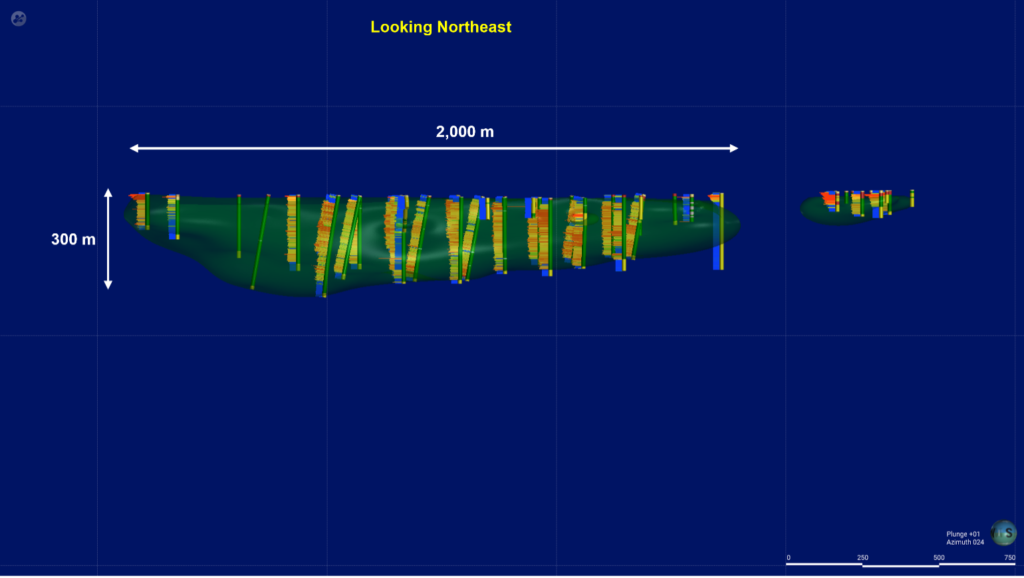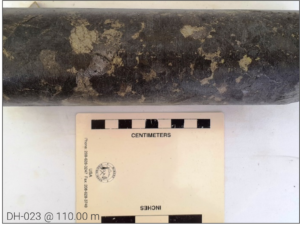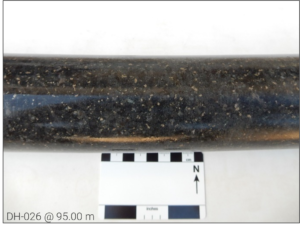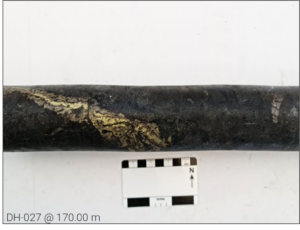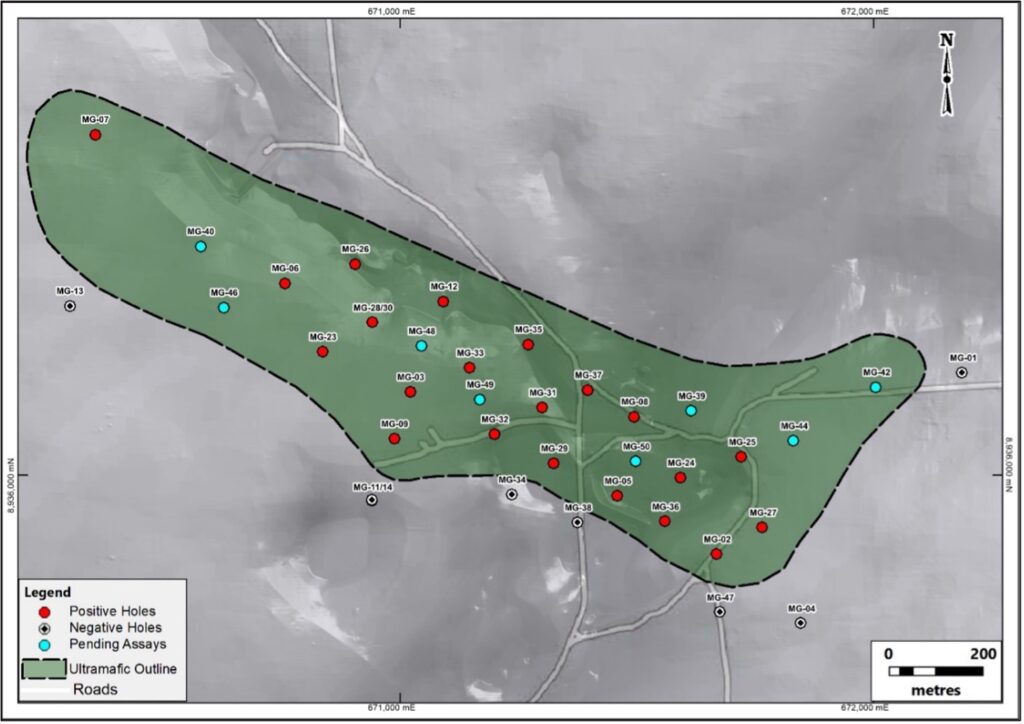
Bahia Nickel (the Company) is pleased to announce that it has received assays for an additional twelve holes from its current 6,000-meter diamond drilling program at the Mangueiros sulphide Ni-Cu-Co project, located in the municipality of Pilão Arcado, Bahia state in Brazil.
The twelve holes are part of an initial 30-hole program, which started in May 2022 and will be completed by the end of the year. The current drilling program includes infill and step out drilling leveraging the historical drill grid as a base. Two drill rigs are currently operating on site and twenty-seven holes have been completed for a total of 5,446 meters.
Of the newly received 12 holes, 10 are positive holes and are in line with the results of the historical drilling. In addition, the results are in line with the initial four holes of the current program as reported in September 2022. The new results continue to confirm the main geologic characteristics of Mangueiros prospect. This includes the very wide intercepts of mineralization from below the relatively shallow base of oxidation and all the way through to the base of the mafic-ultramafic unit to the contact with the basement metasediments. Highlights from the recent results include:
- MGDH-027: 177.00 m @ 0.20% Ni; 0.15% Cu; 0.018% Co (from 32.00 m)
- MGDH-029: 180.15 m @ 0.20% Ni, 0.13% Cu; 0.018% Co (from 17.85 m)
- MGDH-032: 176.30 m @ 0.20% Ni; 0.13% Cu; 0.019% Co (from 18.70 m)
- MGDH-035: 128.75 m @ 0.21% Ni; 0.15% Cu; 0.017% Co (from 15.40 m)
- MGDH-036: 193.61 m @ 0.21% Ni; 0.16% Cu; 0.020% Co (from 26.39 m)
- MGDH-037: 172.00 m @ 0.22% Ni; 0.16% Cu; 0.015% Co (from 18.00 m)
Out of these twelve holes, two holes (MGDH-034 and MGDH-038) that were located to trace the southern contact of the ultramafic sill, are outside the mineralized domain as they drilled through the metasediments outside of the ultramafic sill.
Mr. Elton Pereira, Bahia Nickel’s Country Manager, states: “We are very pleased with these additional results that now count fourteen positive holes on our current drill program, that combined with eight positive historical holes, counts for twenty-two positive holes inside the Ni-Cu-Co ultramafic host rock. All this has considerably de-risked Mangueiros project, and we are even more confident on its vertical and lateral continuity of mineralization, which extends for at least 2,000 meters along strike and a width of 500 meters, but which is still open in all directions. The broad, boat-shaped volume of the nickel-copper-cobalt sulphide mineralization, located at shallow depths, points to a very favorable geometry for potential future open-pit designs and associated waste to ore ratios.”
After completing the current drilling program, Bahia Nickel plans the following actions for 2023:
- Proceed with initial mineral resource estimate (inferred) in Q1 2023.
- Perform initial metallurgical test work on core composite samples in Q1 2023.
- Further de-risking the Mangueiros project by executing another campaign of infill (mostly) and step out drilling in Q2-Q3 2023.
- Define mineral resource estimate in the measured and/or indicated category in Q3/Q4 2023.
- Prepare a Preliminary Economic Assessment (PEA) in Q3/Q4 2023.
- Exploratory drilling on additional magnetics/electromagnetics anomalies that were generated by a recently completed helicopter borne survey executed by CBPM, the Bahia state mining company, Bahia Nickel’s partner at Mangueiros project. This survey has identified, over the project’s areas, Mag/EM anomalies with signals analogous to those of Mangueiros ultramafic intrusion.
The following table summarizes the mineralized intercepts of the latest returned assays. Their location may be identified in Figure 1 further down.
| Hole | Length (m) | Ni | Cu | Co | NiEq | CuEq | Starting at (m) |
|---|---|---|---|---|---|---|---|
| MGDH-023 | 231.50 | 0.21% | 0.14% | 0.01% | 0.28% | 0.88% | 28.50 |
| MGDH-024 | 184.25 | 0.21% | 0.16% | 0.01% | 0.29% | 0.90% | 14.75 |
| MGDH-025 | 150.00 | 0.20% | 0.13% | 0.02% | 0.27% | 0.86% | 23.00 |
| MGDH-026 | 171.75 | 0.21% | 0.17% | 0.01% | 0.29% | 0.91% | 20.00 |
| MGDH-027 | 177.00 | 0.20% | 0.15% | 0.02% | 0.28% | 0.89% | 32.00 |
| MGDH-028 | 245.30 | 0.14% | 0.11% | 0.01% | 0.20% | 0.64% | 17.70 |
| MGDH-029 | 180.15 | 0.20% | 0.13% | 0.02% | 0.28% | 0.87% | 17.85 |
| MGDH-030 | 199.00 | 0.17% | 0.12% | 0.01% | 0.24% | 0.74% | 19.00 |
| MGDH-031 | 243.00 | 0.16% | 0.11% | 0.01% | 0.22% | 0.69% | 26.00 |
| MGDH-032 | 176.30 | 0.20% | 0.13% | 0.02% | 0.28% | 0.87% | 18.70 |
| MGDH-033 | 183.00 | 0.19% | 0.13% | 0.01% | 0.26% | 0.81% | 88.00 |
| MGDH-034 | Outside the ultramafic sill | ||||||
| MGDH-035 | 128.75 | 0.21% | 0.15% | 0.02% | 0.29% | 0.91% | 15.40 |
| MGDH-036 | 193.61 | 0.21% | 0.16% | 0.02% | 0.30% | 0.94% | 26.39 |
| MGDH-037 | 172.00 | 0.22% | 0.16% | 0.02% | 0.29% | 0.91% | 18.00 |
| MGDH-038 | Outside the ultramafic sill |
Notes:
1. Reported nickel comes from ammonia citrate + hydrogen peroxide digestion that extracts nickel only from the sulphides.
2. Interval composites chosen within a nominal 0.10% Ni gradeshell.
3. Metal prices (US$/t) for NiEq & CuEq → Ni: 25,000 – Cu: 8,000 – Co: 50,000
Sampling, preparation, and assaying procedures
Drill cores are 100% completed with HQ diameter (63.5mm) which are placed into core cases delivered in the Company’s shed field facility, where each drilling advance versus recovery is checked/confirmed. Density and magnetic susceptibility measurements are made at regular intervals. Drill cores are cut on a diamond saw in two longitudinal splits. The Company’s geologists log all core geological features and mark the sampling intervals that are mostly one meter long. Samples are always collected at the right split of the drill cores. Each sample is marked on the core trays and put into plastic bags that are internally and externally identified. Each sample bag is tied/locked with plastic straps and assembled with other samples inside PVC bags that collectively, compose the sample batches for each of the drill holes. Samples are transported, from the Company’s site facility to the lab, on a dedicated box truck freighter.
Drill core samples are sent to the ALS lab facility in Vespasiano, Minas Gerais state where sample preparation is done. Assays are done at the ALS lab facility in Lima, Peru. Core samples are dried at 110º C and 100% crushed to 70% < 2mm. A 250g crushed split is obtained to be ground at 85% < 75µ (200#). An aliquot of the ground split is leached with ammonia citrate + hydrogen peroxide for nickel-sulphide assay with ICP-AES finishing. In a 30g split, Au, Pt and Pd are assayed with fire-assay/ICP-AES finishing and in another split, multi-element analysis is done with four-acid digestion and ME-ICP finishing.
For QA/QC purposes, duplicate samples, blanks, and reference samples (from nickel sulphide ores) produced and sold by AMIS from South Africa, are regularly inserted in all core batches.
About Mangueiros Project and Bahia Nickel
Bahia Nickel is a private company formed to explore the Mangueiros project after winning a public auction process and signing an agreement for this project in December 2021 with the Bahia state mining company, Companhia Baiana de Pesquisa Mineral (CBPM). The agreement gives the Company the right to conduct further exploration over the project area for 3 years, being Bahia Nickel after this period, entitled to sign a Mining Lease Agreement for 20 years, with the option to extend it for an additional 10 years, allowing the mining operation of the mineral deposit.
Located in the northern region of the mining-friendly Bahia state, Mangueiros is a greenfield exploration project for sulphide nickel, copper, and cobalt deposits. The Mangueiros prospect has 3,051m of historical drilling into the main target, that indicates the existence of a thick, wide, and continuous near-surface mineralization on an ultramafic intrusion that contains continuous magmatic sulphide mineralization.
